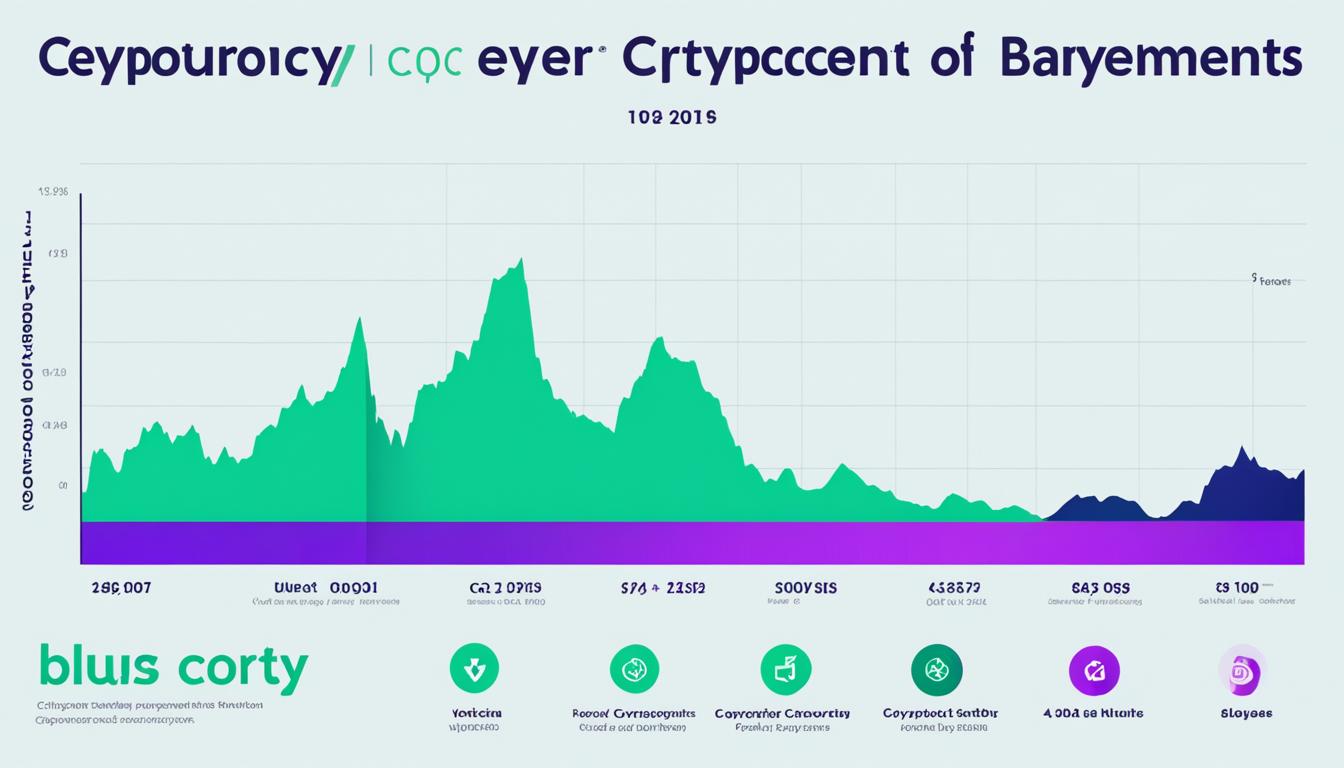Contents
- 1 The Difference Between Bitcoin and Ethereum
- 1.1 Understanding the Fundamentals of Bitcoin and Ethereum
- 1.2 Bitcoin vs Ethereum: The Technological Divide
- 1.3 Bitcoin vs Ethereum: Analyzing Market Capitalization and Performance
- 1.4 The Distinct Purposes of BTC and ETH in the Crypto Ecosystem
- 1.5 “Bitcoin vs Ethereum”: A Comparison of Investment Strategies
- 1.6 Adaptive Changes: How BTC and ETH Continue to Evolve
- 1.7 Market Dynamics: Analyzing Price Fluctuations in Bitcoin and Ethereum
- 1.8 Comparative Use Cases: How BTC and ETH Differ in Utility
- 1.9 FAQ
- 1.9.1 What is the difference between Bitcoin and Ethereum?
- 1.9.2 How do the blockchain technologies used by Bitcoin and Ethereum differ?
- 1.9.3 What factors should I consider when comparing the market capitalization and performance of Bitcoin and Ethereum?
- 1.9.4 What are the distinct purposes of Bitcoin and Ethereum in the crypto ecosystem?
- 1.9.5 Do investment strategies differ for Bitcoin and Ethereum?
- 1.9.6 How are Bitcoin and Ethereum evolving through protocol upgrades and network enhancements?
- 1.9.7 What factors should I consider when analyzing price fluctuations in Bitcoin and Ethereum?
- 1.9.8 How do Bitcoin and Ethereum differ in terms of utility and use cases?
- 1.9.9 What are the investment opportunities for Bitcoin and Ethereum?
- 1.9.10 How are Bitcoin and Ethereum adapting to new technologies and market demands?
The Difference Between Bitcoin and Ethereum
As the dawn of the cryptocurrency era took the world by storm, a striking feature has emerged from the haze of digital finance; Bitcoin and Ethereum together account for a staggering majority of the crypto market’s value. While these two giants of the decentralized realm hold prominence, they stand apart, each a beacon on the divergent paths of blockchain evolution. Your understanding of Bitcoin vs Ethereum could be the key that unlocks a trove of investment opportunities within the bustling crypto market.
Often seen as the gold and silver of the digital currency world, Bitcoin and Ethereum paint a vivid picture of diversity in the realm of virtual currencies. Bitcoin, hailing as the original digital currency, presents itself as digital gold, a store of value amid the roiling seas of price volatility. In contrast, the Ethereum network thrives as a hotbed for decentralized finance (DeFi applications) and smart contracts, promising innovations and functionalities beyond mere currency.
Whether you’re deep in the throes of cryptocurrency exchange, tracking blockchain network analysis, or pondering your next move in cryptocurrency investment strategies, distinguishing between these two titans—Bitcoin and Ethereum—could mean the difference between a good investment and a great one. So let’s explore the nuances of blockchain technology, the cunning edge of crypto market analysis, and the insight of digital currency analysis, guiding your path through the undulating cryptocurrency market trends. Given the rapid development of Ethereum 2.0 upgrade and the enduring dominance of the Bitcoin market, your finger on the pulse of these digital assets has never been more crucial in predicting the future of Bitcoin and Ethereum.
Key Takeaways
- Understanding the fundamental differences in blockchain technology can inform your decision when choosing between Bitcoin and Ethereum.
- The roles of Bitcoin as digital gold and Ethereum as an enabler of DeFi highlight their distinct investment options.
- Monitoring Bitcoin market trends and conducting Ethereum price analysis are vital for developing sound investment strategies.
- Cryptocurrency price comparison and crypto market analysis provide a clear view of the current investment opportunities.
- Staying informed about cryptocurrency competition and the evolving blockchain network can enhance cryptocurrency investment strategies.
- Emerging market trends and the anticipation of future market behaviors are essential for cryptocurrency analysis trends.
- Consider how the future market trends, like the Ethereum 2.0 upgrade, may influence the landscape of cryptocurrency investment.
Understanding the Fundamentals of Bitcoin and Ethereum
The exploration of cryptocurrency foundations begins with two monumental innovations: Bitcoin and Ethereum. Both have played pivotal roles in the digital currency evolution and the blockchain revolution, prompting a radical rethink of how we perceive value transfer and contractual agreements. Grasping the Bitcoin fundamentals as a pioneer digital currency and Ethereum fundamentals as a versatile platform for decentralized applications is crucial for comprehending the depth of change these technologies have introduced.
Though they share the common ground of blockchain technology, the paths diverge when analyzing Bitcoin as a digital currency and Ethereum as a platform. This distinction lays at the core of their respective contributions to the advancement of cryptocurrency features and decentralized financial infrastructure.
Bitcoin: The Pioneer of Digital Currency
Satoshi Nakamoto’s creation of Bitcoin in 2009 forever changed the digital payment systems landscape. Operating on a decentralized ledger, Bitcoin’s blockchain allows for peer-to-peer transactions worldwide. This innovation was not merely technological; it symbolized a turn towards cryptocurrency adoption on a global scale. Bitcoin history is thus a testament to cryptocurrency innovation, underpinning the very concept of what we now consider digital currency basics.
Ethereum: A Platform for Decentralized Applications and Smart Contracts
Ethereum, pioneered by Vitalik Buterin in 2015, extended blockchain applications beyond mere currency. The Ethereum platform introduced smart contract technology, enabling self-executing contracts with the terms of agreements directly written into code. The Ethereum ecosystem empowers developers to create dApps and smart contracts, steering the decentralized finance (DeFi) movement. Its programmable blockchain represents a pivot from the traditional digital payment systems into a future where applications are decentralized, and financial services are liberalized from conventional institutions.
To encapsulate, Bitcoin’s and Ethereum’s influence traverses cryptocurrency technology and heralds a new era of financial autonomy. Their diverse roles underscore the multifaceted nature of blockchain development and its impact on the digital era. As we delve deeper into blockchain applications and decentralized systems, the knowledge of Bitcoin and Ethereum fundamentals becomes ever more pivotal in remaining at the forefront of cryptocurrency innovation.
Bitcoin vs Ethereum: The Technological Divide
When exploring the digital currency landscape, two giants stand out: Bitcoin and Ethereum. Both harness blockchain technology, but their foundational technologies diverge significantly, leading to a spectrum of differences in terms of blockchain security, transactional capabilities, and overall digital currency mechanisms. Understanding these differences is pivotal for grasping the broader implications of cryptocurrency protocols and the evolution of blockchain comparisons.
Differences in Blockchain Technology
The Bitcoin blockchain is architected around a proof of work (PoW) consensus mechanism, requiring Bitcoin mining as a method for transaction validation and network security. Anchored in the process of mining, this approach has long been heralded for its robustness but critiqued for scalability concerns. Conversely, the Ethereum blockchain, transitioning to a proof of stake (PoS) with Ethereum staking, ushers in a new era of blockchain scalability and energy efficiency. These blockchain technology differences illustrate the unique pathways each cryptocurrency has charted in the pursuit of decentralization.
Proof of Work versus Proof of Stake Mechanisms
Consensus mechanisms are the bedrock of blockchain security, dictating how transactions are confirmed and how new blocks are added to the chain. Bitcoin’s reliance on proof of work lays the foundation for an energy-intensive model where miners vie to solve cryptographic puzzles. Ethereum’s strategic shift to proof of stake is aimed at reducing this energy footprint by choosing validators based on the cryptocurrency tokens they hold and are willing to ‘stake’. As such, the contrasting consensus algorithms underpin variations in not only blockchain security but also in the philosophies of protocol governance and currency issuance.
Transactional Differences and Their Implications
A closer look at cryptocurrency transactions uncovers significant disparities between Bitcoin and Ethereum. Bitcoin has been honed as a peer-to-peer system optimized for security and reliability in cryptocurrency transactions. Ethereum, with its advanced transactional capabilities, facilitates not only cryptocurrency exchanges but also complex contractual agreements and decentralized applications (dApps). The transaction confirmation speed tends to be faster on Ethereum, which also aims for greater blockchain scalability to accommodate a vast network of dApps. These cryptocurrency transactional differences have wide-ranging blockchain implications for users and developers alike.
Bitcoin vs Ethereum: Analyzing Market Capitalization and Performance
As you delve into the world of cryptocurrencies, understanding the market value comparison between Bitcoin market capitalization and Ethereum market capitalization becomes vital for gauging the investment potential of these digital assets. Accurately assessing the cryptocurrency market trends not only informs investment choices but also offers a glimpse into the factors driving the popularity and adoption of these leading cryptocurrencies.
While Bitcoin has long been the king of the crypto hill, Ethereum’s growing market capitalization signifies its increasing dominance and adoption in the digital asset space.
The BTC vs ETH market cap narrative is constantly evolving. Historically, Bitcoin has boasted a larger market cap, underscoring its status as the inaugural digital asset with paramount market dominance. However, investors have witnessed a surge in Ethereum’s market cap, indicative of its burgeoning role in applications beyond mere currency – such as smart contracts and decentralized applications (dApps).
Market watchers keen on cryptocurrency performance analysis often scrutinize cryptocurrency investment returns, closely analyzing historical data and market sentiments. Significant growth in Bitcoin price analysis charts reflects investor trust, despite periods of sharp volatility. On the other hand, Ethereum price analysis indicates a robust performance, often tethered to its platform’s technological advancements and its effect on the broader ecosystem.
To provide a clearer perspective on the digital asset performance, consider that cryptocurrency popularity isn’t merely about numbers; it’s also about functionality and the potential to revolutionize industries.
An intricate part of this analysis is the comparing market value between Bitcoin and Ethereum, which can guide you on the investment potential of both. Acknowledging their respective roles, functionalities, and the community’s endorsement can offer crucial insights into these assets’ future.
Here is a comparison of the current state of Bitcoin and Ethereum’s market capitalizations:
| Indicator | Bitcoin (BTC) | Ethereum (ETH) |
|---|---|---|
| Market Cap | $XXX Billion | $XXX Billion |
| 24h Trading Volume | $XXX Billion | $XXX Billion |
| Price Change (24h) | X% | X% |
| Circulating Supply | XX Million BTC | XX Million ETH |
While the above table presents a snapshot of their market presence, it is the deeper cryptocurrency market analysis that often unravels the narratives and trends influencing these numbers. Shrewd investors monitor these factors, complementing their understanding of market dynamics with detailed analyses to maximize returns.
The question of cryptocurrency market dominance is more than just a tale of figures; it’s a story of innovation, community conviction, and the transformative potential of technology in creating a decentralized financial landscape. Our scrutiny of Bitcoin and Ethereum underscores the need for a tactical approach to investment in this exhilarating yet volatile market.
The Distinct Purposes of BTC and ETH in the Crypto Ecosystem
Bitcoin and Ethereum cater to specific needs and both fulfill critical roles within the cryptocurrency ecosystem. While Bitcoin maintains its stature as the embodiment of digital gold, providing a reliable store of value, Ethereum carves a niche as a revolutionary platform for decentralized finance (DeFi) and decentralized applications (dApps). The inherent characteristics of these leading cryptocurrencies position them to serve as both a financial infrastructure and a hub for innovation in blockchain-based finance.
Ethereum’s Role in Enabling DeFi and dApps
When you delve into Ethereum’s purpose, it’s evident that its contribution to the cryptocurrency functions extends far beyond being just a digital currency. Ethereum is celebrated as a platform that underpins the burgeoning industry of DeFi, which leverages smart contracts to create a decentralized financial infrastructure. This innovation has given rise to various DeFi applications, offering alternatives to traditional banking without the intermediaries. Moreover, Ethereum’s adeptness at facilitating digital asset management through its dApps ecosystem has cemented its position as the foundational infrastructure for cryptocurrency utility and pioneering cryptocurrency use cases.
Bitcoin’s Role as Digital Gold: A Store of Value
In contrast, the Bitcoin purpose aligns closer to that of a traditional currency but with a digital twist. Often touted as a store of value, Bitcoin shares characteristics with gold — scarcity, durability, and the capacity to withstand economic fluctuations. Its finite supply parallels the scarcity of precious metals, giving rise to its moniker as digital gold. Investors perceive Bitcoin as a viable Bitcoin investment opportunity, considering its track record for value preservation over time, rendering it indispensable for those managing financial transactions and digital asset storage with a long-term investment lens.
Understanding the dynamic roles of Bitcoin and Ethereum reveals their indispensability in today’s digital economy. As each fulfills its distinct role—Bitcoin as a currency and Ethereum as a platform—they collectively undergird a vast and multifaceted cryptocurrency ecosystem. Whether weighing a Bitcoin investment against an Ethereum investment, or assessing the DeFi market analysis, the nuanced roles of these cryptocurrencies guide investors and users through the complex landscape of digital currency roles and blockchain-based finance.
“Bitcoin vs Ethereum”: A Comparison of Investment Strategies
As you delve into the complex world of cryptocurrencies, understanding the nuances of Bitcoin investment strategies and Ethereum investment strategies is vital to navigate the dynamic financial landscape. Reflect on your investment goals and risk tolerance; these factors are foundational in building a robust crypto portfolio management plan. Considering Bitcoin as an investment offers a frame through which to view its potential as a long-term store of value, while evaluating Ethereum as an investment presents a different approach focused on its integral role in emerging decentralized applications and finance.
When analyzing cryptocurrency market trends, it’s evident that portfolio diversification is more than a buzzword; it is an essential strategy for managing investment risk analysis. Allocating assets between Bitcoin and Ethereum can be likened to balancing the stability of gold with the growth potential of innovative stocks. An encompassing cryptocurrency investment analysis will reveal how these two giants differ in terms of risk management and investment returns, guiding you towards informed cryptocurrency allocation.
A discerning investor acknowledges the significance of investment planning and investment horizon. Investment strategies for beginners may lean towards conservative choices, whereas seasoned participants might engage in more diverse cryptocurrency diversification. Experienced advisors suggest that thorough cryptocurrency market analysis precedes any investment decision, underlining the necessity for diligent research and a solid crypto investment guide.
Investment opportunities in the cryptocurrency space are intertwined with market volatility. As such, your strategy might present a spectrum of scenarios, ranging from aggressive to conservative cryptocurrency allocation. Below, you’ll find a comparative analysis that can assist you in identifying the most suitable approach for your individual needs:
| Investment Aspect | Bitcoin Strategy | Ethereum Strategy |
|---|---|---|
| Investment Horizon | Geared towards long-term holding | Favors both short-term and long-term perspectives |
| Risk Profile | Lower risk with historical stability as a store of value | Higher risk with potential for substantial growth |
| Market Trends | More resistant to market trends due to established reputation | Highly responsive to market trends and technological advancements |
| Return Potential | Stable growth, favored as a hedge against inflation | Potentially higher returns, influenced by the success of dApps and DeFi sector |
In conclusion, the realms of Bitcoin and Ethereum investment strategies offer a landscape of options for both veterans and novices. By incorporating investment risk analysis and keeping abreast of cryptocurrency market trends, you can position yourself to capitalize on the disruptive potency of these investment vehicles. No matter the path you elect within the cryptocurrency domain, remember that informed decisions, shaped by a calculated symbiosis of your financial blueprint and the evolving crypto markets, is the cornerstone of a sagacious investor’s journey.
Adaptive Changes: How BTC and ETH Continue to Evolve
The cryptocurrency landscape is ever-changing, with Bitcoin and Ethereum at the forefront of this dynamic industry. Driven by a commitment to continuous improvement and responding to user needs, both platforms are known for their regular network upgrades and protocol improvements. The result is a vibrant ecosystem characterized by a robust increase in the cryptocurrency adoption rate and technological advancements.
The pursuit of cryptocurrency scalability and network security has led to significant blockchain advancements, sharply focusing on enhancing the user experience and increasing system efficiency. Staying abreast of these changes is vital for anyone involved in the crypto market, as it influences the cryptocurrency evolution, informing both short and long-term strategies.
Upgrades and Enhancements: From Taproot to Ethereum 2.0
The Bitcoin Taproot upgrade marks a pivotal moment in blockchain network development, enhancing privacy and efficiency while softening the ground for smart contract functionality. Similarly, the Ethereum 2.0 upgrade is a transformative leap forward, attempting to dramatically improve network scalability through proof-of-stake (PoS) and shard chains, ensuring the blockchain can handle transactions more swiftly and sustainably.
Expanding Possibilities Through Network Enhancements
These protocol improvements breathe new life into the crypto space, serving as a backbone for future blockchain technology advancements. The impact of these network enhancements is not limited to technical aspects; it plays a crucial role in expanding the potential applications of cryptocurrencies, potentially triggering a surge in the cryptocurrency ecosystem growth.
Technology improvements such as these generate a ripple effect that spurs cryptocurrency innovation and shapes the cryptocurrency future. As crypto market trends continue to evolve, network enhancements ensure that blockchain’s adaptability remains robust, addressing the burgeoning demands of the global financial system and securing blockchain’s place as a cornerstone of modern technology.
Market Dynamics: Analyzing Price Fluctuations in Bitcoin and Ethereum
Navigating the complexities of cryptocurrency market dynamics involves a deep dive into Bitcoin price fluctuations and Ethereum price fluctuations. These two cryptocurrencies are benchmarks for assessing the health and sentiments of the broader market, providing valuable insights into both price volatility analysis and market psychology. Your understanding of these dynamics is critical for making informed investment decisions and for speculating about future price trends.
Historical Price Trends and What They Suggest About the Future
Historical price trends serve as a foundation for any crypto market analysis. Through examining past movements, you derive a context for the present and a vantage point for future forecasting. These trends are paramount for constructing a comprehensive Bitcoin price analysis and Ethereum price analysis, allowing for a better grasp of cryptocurrency market factors that could influence price movement.
The chart below illustrates the cryptocurrency market trends over the past decade, emphasizing the dramatic surges and declines that characterize market volatility.
| Year | Bitcoin Price | Ethereum Price | Market Sentiments |
|---|---|---|---|
| 2013 | $100 – $1,200 | N/A | Early Adoption |
| 2017 | $998 – $19,666 | $8 – $715 | ICO Explosion |
| 2020 | $7,200 – $29,000 | $140 – $730 | Pandemic Response |
Volatility and Market Sentiments as Driving Factors
Understanding price speculation and investor sentiments is just as important as recognizing market factors affecting price. The cryptocurrency market is known for its swift changes in valuation, often driven by news, technological advancements, or macroeconomic factors. These can significantly affect the price forecasting efforts.
Reflect on how a tweet from a known influencer or an announcement of regulation can sway price movement almost immediately. A nuanced perspective on these market sentiments can provide an edge to your cryptocurrency price analysis.
Engaging with this level of market understanding requires recognizing the inherent risks and rewards that come with the territory of cryptocurrency investments. Whether you’re looking at the Bitcoin price analysis or the Ethereum price analysis, a clear perspective on market dynamics could make a substantial difference in outcomes.
Market analysis in the realm of cryptocurrencies is a complex task. It comprises of a mixture of quantitative data and qualitative insights, ensuring a multifaceted approach to price volatility analysis. Be aware that while historical data is indicative, it is not predictive, and market dynamics remain fluid and ever-evolving. With due diligence and a keen eye on market psychology, it’s possible to navigate the tumultuous waters of Bitcoin and Ethereum price fluctuations.
Comparative Use Cases: How BTC and ETH Differ in Utility
Bitcoin and Ethereum, while both pioneers in digital currency applications, cater to distinct needs within the blockchain ecosystem. Bitcoin use cases have historically centered on financial transactions, optimizing peer-to-peer transactions, and enhancing cross-border payments with unparalleled security and transactional efficiency. As a stalwart in the crypto world, Bitcoin’s robust global financial infrastructure allows you to manage digital transactions seamlessly, reaffirming its status as a premier choice for digital assets.
Ethereum’s canvas, however, is broader with use cases expanding into smart contract applications and decentralized applications (dApps) that are revolutionizing blockchain integration across industries. Real-world uses of Ethereum are abundant, driven by its ability to facilitate decentralized finance adoption, providing a foundation for a new era of blockchain-based solutions. The Ethereum network’s unique ability to execute smart contracts has ignited a surge in cryptocurrency adoption, influencing sectors across finance, supply chain, and even healthcare with its promise of transparent and automated transactions.
The judicious leverage of Bitcoin and Ethereum can significantly impact your venture into the crypto universe. As digital currency benefits proliferate, adopting cryptocurrency payment solutions becomes crucial for thriving in a digitally-driven economy. Whether you’re investing in digital currencies or integrating them into your business infrastructure, understanding these cryptocurrencies’ practical applications is essential. With Bitcoin championing efficient digital transactions and Ethereum redefining how decentralized finance operates, both continue to offer a plethora of opportunities for savvy users and investors alike.
FAQ
What is the difference between Bitcoin and Ethereum?
Bitcoin and Ethereum are two of the most significant and popular cryptocurrencies in the market. While both are digital currencies, they have distinct purposes and technological differences. Bitcoin is often referred to as digital gold and a store of value, while Ethereum is a platform for decentralized applications (dApps) and smart contracts.
How do the blockchain technologies used by Bitcoin and Ethereum differ?
The blockchain technologies used by Bitcoin and Ethereum differ in various aspects, including transactional capabilities and consensus mechanisms. Bitcoin relies on a blockchain with a proof-of-work (PoW) consensus mechanism, while Ethereum has shifted to a proof-of-stake (PoS) mechanism. These differences impact decentralization, scalability, and security in both Bitcoin and Ethereum.
What factors should I consider when comparing the market capitalization and performance of Bitcoin and Ethereum?
Market capitalization and performance are key factors to consider when comparing Bitcoin and Ethereum. Bitcoin has historically held a significant market cap, often surpassing other cryptocurrencies, including Ethereum. However, Ethereum’s market capitalization has been steadily growing, reflecting the increasing adoption and investor interest in the platform. Analyzing price fluctuations and market dynamics is crucial for understanding the differences between Bitcoin and Ethereum.
What are the distinct purposes of Bitcoin and Ethereum in the crypto ecosystem?
Bitcoin serves as a digital store of value and a peer-to-peer digital currency, allowing users to send and receive funds globally. Ethereum, on the other hand, enables decentralized finance (DeFi) and the development of decentralized applications (dApps) through its programmable blockchain and smart contract technology. Bitcoin and Ethereum are utilized for different purposes in the cryptocurrency ecosystem.
Do investment strategies differ for Bitcoin and Ethereum?
Investment strategies for Bitcoin and Ethereum differ depending on factors like risk tolerance and long-term goals. Bitcoin is often perceived as a store of value and a potential hedge against inflation, making it attractive for long-term investment. Ethereum, with its role in enabling DeFi and the growth of dApps, presents unique investment opportunities. Diversification between Bitcoin and Ethereum can help manage risks and potential returns in cryptocurrency investments.
How are Bitcoin and Ethereum evolving through protocol upgrades and network enhancements?
Both Bitcoin and Ethereum continue to evolve through protocol upgrades and network enhancements. Bitcoin recently introduced the Taproot upgrade, improving transaction privacy and scalability. Ethereum is undergoing a major upgrade known as Ethereum 2.0, addressing scalability through the implementation of proof-of-stake (PoS) and shard chains. These upgrades demonstrate efforts to improve performance, security, and functionality in both Bitcoin and Ethereum.
What factors should I consider when analyzing price fluctuations in Bitcoin and Ethereum?
Analyzing price fluctuations in Bitcoin and Ethereum requires understanding market dynamics and considering factors such as historical price trends, market sentiments, and price volatility. Market sentiments, including investor confidence, regulatory developments, and geopolitical events, can heavily impact the price movement of Bitcoin and Ethereum. Technical analysis indicators and fundamental market factors should be considered when analyzing price trends and making predictions.
How do Bitcoin and Ethereum differ in terms of utility and use cases?
Bitcoin serves as a digital currency for financial transactions, enabling secure global transfers without intermediaries. Ethereum goes beyond digital currency and serves as a platform for decentralized applications (dApps) and smart contracts. Smart contracts have applications in various industries, such as finance, supply chain, healthcare, and real estate. Ethereum also enables decentralized finance (DeFi) applications, revolutionizing traditional financial services.
What are the investment opportunities for Bitcoin and Ethereum?
Bitcoin and Ethereum offer unique investment opportunities. Bitcoin’s historical performance as a store of value and potential hedge against inflation make it attractive for long-term investment. Ethereum’s role in enabling decentralized finance and its potential growth in the dApps market present interesting investment opportunities. Understanding market trends, conducting thorough research, and aligning investment strategies with individual goals are crucial for successful cryptocurrency investments.
How are Bitcoin and Ethereum adapting to new technologies and market demands?
Bitcoin and Ethereum continue to evolve through upgrades and enhancements, demonstrating their ability to adapt to new technologies and meet market demands. Bitcoin’s recent Taproot upgrade and Ethereum’s ongoing Ethereum 2.0 upgrade are examples of the continuous efforts to improve performance, security, and functionality in both cryptocurrencies. Keeping up with these advancements is crucial for understanding the potential and limitations of Bitcoin and Ethereum.








Leave a Reply